With this blog, I would like to show one small agent built-in with `LangGraph` and Google Gemini for research purposes. The objective is to demonstrate one research agent (Paper-to-Voice Assistant) who plans to summarize the research paper. This tool will use a vision model to infer the information. This method only identifies the step and its sub-steps and tries to get the answer for those action items. Finally, all the answers are converted into conversations in which two people will discuss the paper. You can consider this a mini NotebookLM of Google.
To elaborate further, I am using a single uni-directed graph where communication between steps happens from top to bottom. I have also used conditional node connections to process repeated jobs.
- A process to build simple agents with the help of Langgraph
- MultiModal Conversation with Google Gemini llm

Table of contents
- Paper-to-Voice Assistant: Map-reduce in Agentic AI
- From Automation to Assistance: The Evolving Role of AI Agents
- What is not included?
- Python Libraries Used
- Paper-to-Voice Assistant: Practical Implementation
- Google Vission Model
- Step 1: Generate Tasks
- Step 2: Plan Parsing
- Step 3 Text To Json
- Step 4: Solution For Each Step
- Step 5: Conditional Loop
- Step 6: Voice
- Step 7: Graph Construction
- Dialog to Voice
- Frequently Asked Questions
Paper-to-Voice Assistant: Map-reduce in Agentic AI
Imagine a massive problem so large that a single person would take several days/months to solve. Now, picture a team of skilled people, each given a specific section of the task to work on. They might start by sorting the plans by objective or complexity, then gradually piecing together smaller sections. Once each solver has completed their section, they combine their solutions into the final one.
This is essentially how map-reduce works in Agentic AI. The main “problem” gets divided into sub-problem statements. The “solvers” are individual LLMs, which map each sub-plan with different solvers. Each solver works on its assigned sub-problem, performing calculations or inferring information as needed. Finally, the results from all “solvers” are combined (reduced) to produce the final output.
From Automation to Assistance: The Evolving Role of AI Agents
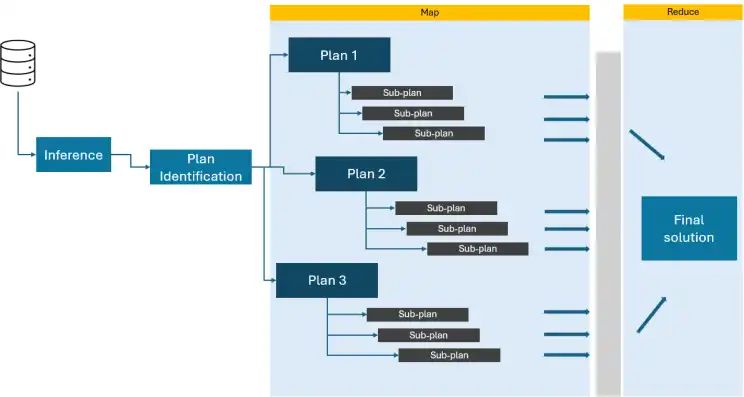
After advancements in generative AI, LLM agents are quite popular, and people are taking advantage of their capabilities. Some argue that agents can automate the process end to end. However, I view them as productivity enablers. They can assist in problem-solving, designing workflow, and enabling humans to focus on critical parts. For instance, agents can serve as automated provers exploring the space of mathematical proofs. They can offer new perspectives and ways of thinking beyond “human-generated” proofs.
Another recent example is the AI-enabled Cursor Studio. The cursor is a controlled environment similar to VS code that supports programming assistance.
Agents are also becoming more capable of planning and taking action, resembling the way humans reason, and most importantly, they can adjust their strategies. They are quickly improving in their ability to analyze tasks, develop plans to complete them and refine their approach through repeated self-critique. Some techniques involve keeping humans in the loop, where agents seek guidance from humans at intervals and then proceed based on those instructions.

What is not included?
- I have not included any tools like search or any custom function to make it more advanced.
- No routing approach or reverse connection is developed.
- No branching techniques are used for parallel processing or conditional job
- Similar things can be implemented by loading pdf and parsing images and graphs.
- Playing with only 3 images in one prompt.
Python Libraries Used
- langchain-google-genai : To connect langchain with Google generative AI models
- python-dotenv: To load secrete keys or any environment variables
- langgraph: To construct the agents
- pypdfium2 & pillow: To convert PDF into images
- pydub : to segment the audio
- gradio_client : to call HF 🤗 model
Paper-to-Voice Assistant: Practical Implementation
Here’s the implementation:
Load the Supporting Libraries
from dotenv import dotenv_values
from langchain_core.messages import HumanMessage
import os
from langchain_google_genai import ChatGoogleGenerativeAI
from langgraph.graph import StateGraph, START, END,MessagesState
from langgraph.graph.message import add_messages
from langgraph.constants import Send
import pypdfium2 as pdfium
import json
from PIL import Image
import operator
from typing import Annotated, TypedDict # ,Optional, List
from langchain_core.pydantic_v1 import BaseModel # ,FieldLoad Environment Variables
config = dotenv_values("../.env")
os.environ["GOOGLE_API_KEY"] = config['GEMINI_API']Currently, I am using a Multimodal approach in this project. To achieve this, I load a PDF file and convert each page into an image. These images are then fed into the Gemini vision model for conversational purposes.
The following code demonstrates how to load a PDF file, convert each page into an image, and save these images to a directory.
pdf = pdfium.PdfDocument("./pdf_image/vision.pdf")
for i in range(len(pdf)):
page = pdf[i]
image = page.render(scale=4).to_pil()
image.save(f"./pdf_image/vision_P{i:03d}.jpg")Let’s display the one page for our reference.
image_path = "./pdf_image/vision_P000.jpg"
img = Image.open(image_path)
imgOutput:
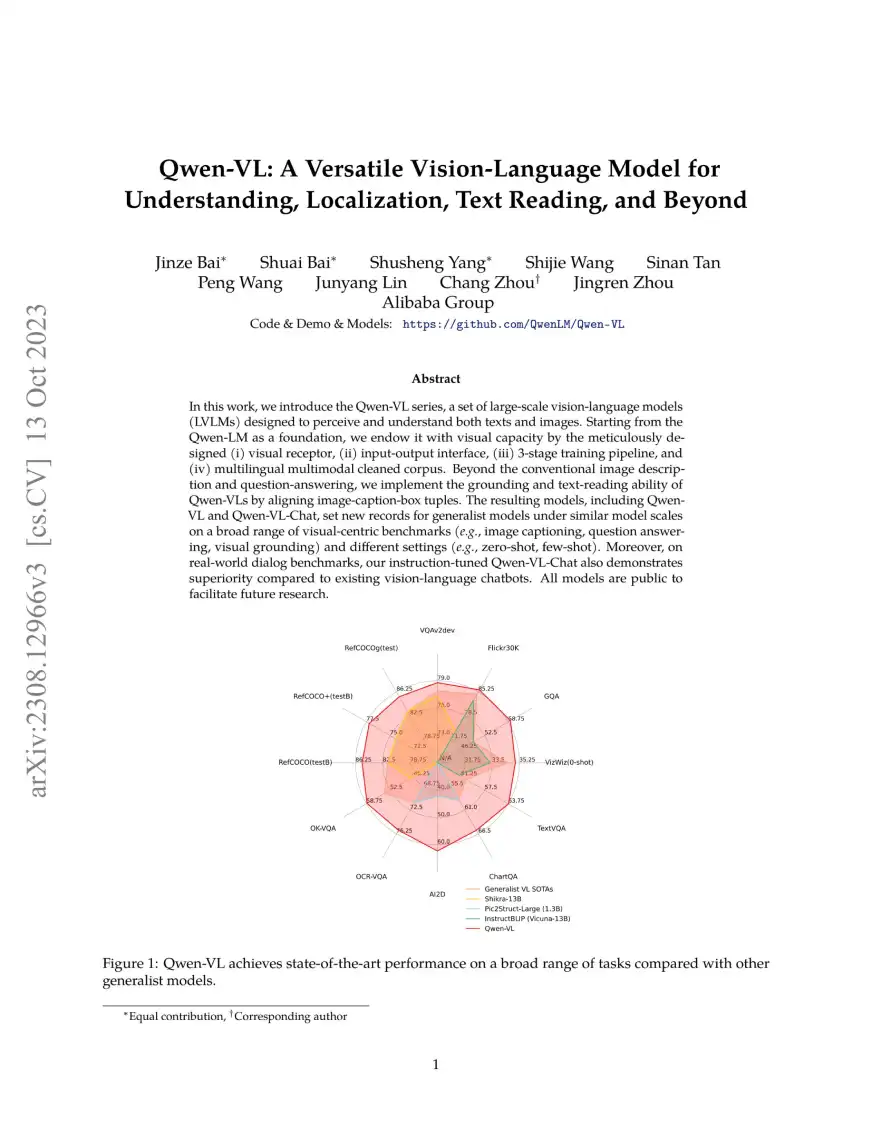
Google Vission Model
Connecting Gemini model through API key. The following are the different variants available. One important thing to notice is that we should select the model that supports the data type. Since I am working with images in the conversation, I needed to opt for either the Gemini 1.5 Pro or Flash models, as these variants support image data.
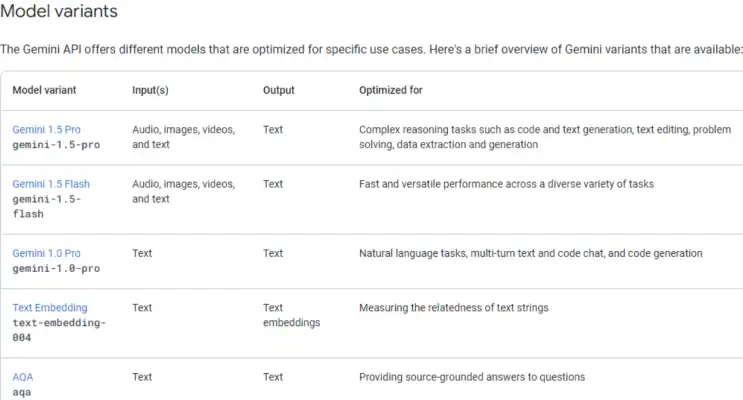
llm = ChatGoogleGenerativeAI(
model="gemini-1.5-flash-001", # "gemini-1.5-pro",
temperature=0,
max_tokens=None,
timeout=None,
max_retries=2,
)
Let’s move forward by building the schema to manage the output and transfer information between nodes. Utilize the add operator to merge all the steps and sub-steps that the agent will create.
class State(TypedDict):
image_path: str # To store reference of all the pages
steps: Annotated[list, operator.add] # Store all the steps generated by the agent
substeps: Annotated[list, operator.add] # Store all the sub steps generated by the agent for every step
solutions: Annotated[list, operator.add] # Store all the solutions generated by the agent for each step
content:str # store the content of the paper
plan:str # store the processed plan
Dialog: Annotated[list, operator.add]The Schema to control the output of the first step.
class Task(BaseModel):
task: strSchema will store the output of each sub-step based on the tasks identified in the previous step.
class SubStep(BaseModel):
substep: strSchema to control the output during conditional looping.
class StepState(TypedDict):
step: str
image_path: str
solutions: str
Dialog: strStep 1: Generate Tasks
In our first step, we’ll pass the images to the LLM and instruct it to identify all the plans it intends to execute to understand the research paper fully. I’ll provide multiple pages at once, asking the model to generate a combined plan based on all the images.
def generate_steps(state: State):
prompt="""
Consider you are a research scientist in artificial intelligence who is expert in understanding research papers.
You will be given a research paper and you need to identify all the steps a researcher need to perform.
Identify each steps and their substeps.
"""
message = HumanMessage(content=[{'type':'text','text':prompt},
*[{"type":'image_url','image_url':img} for img in state['image_path']]
]
)
response = llm.invoke([message])
return {"content": [response.content],"image_path":state['image_path']}Step 2: Plan Parsing
In this step, we will take the plan identified in the first step and instruct the model to convert it into a structured format. I have defined the schema and included that information with the prompt. It’s important to note that external parsing tools can be used to transform the plan into a proper data structure. To enhance robustness, you could use “Tools” to parse the data or create a more rigorous schema as well.
def markdown_to_json(state: State):
prompt ="""
You are given a markdown content and you need to parse this data into json format. Follow correctly key and value
pairs for each bullet point.
Follow following schema strictly.
schema:
[
{
"step": "description of step 1 ",
"substeps": [
{
"key": "title of sub step 1 of step 1",
"value": "description of sub step 1 of step 1"
},
{
"key": "title of sub step 2 of step 1",
"value": "description of sub step 2 of step 1"
}]},
{
"step": "description of step 2",
"substeps": [
{
"key": "title of sub step 1 of step 2",
"value": "description of sub step 1 of step 2"
},
{
"key": "title of sub step 2 of step 2",
"value": "description of sub step 2 of step 2"
}]}]'
Content:
%s
"""% state['content']
str_response = llm.invoke([prompt])
return({'content':str_response.content,"image_path":state['image_path']})Step 3 Text To Json
In the 3rd step, we will take the plan identified in 2nd step and convert it into JSON format. Please note that this method may not always work if LLM violates the schema structure.
def parse_json(state: State):
str_response_json = json.loads(state['content'][7:-3].strip())
output = []
for step in str_response_json:
substeps = []
for item in step['substeps']:
for k,v in item.items():
if k=='value':
substeps.append(v)
output.append({'step':step['step'],'substeps':substeps})
return({"plan":output})Step 4: Solution For Each Step
The solution findings of every step will be taken care of by this step. It will take one plan and combine all the sub-plans in a pair of Questions and Answers in a single prompt. Furthermore, LLM will identify the solution of every sub-step.
This step will also combine the multiple outputs into one with the help of the Annotator and “add” operator. For now, this step is working with fair quality. However, it can be improved by using branching and translating every sub-step into a proper reasoning prompt.
Mainly, every substep should get translated into a chain of thought so that LLM can prepare a solution. One can use React as well.
def sovle_substeps(state: StepState):
print(state)
inp = state['step']
print('solving sub steps')
qanda = ' '.join([f'\n Question: {substep} \n Answer:' for substep in inp['substeps']])
prompt=f""" You will be given instruction to analyze research papers. You need to understand the
instruction and solve all the questions mentioned in the list.
Keep the pair of Question and its answer in your response. Your response should be next to the keyword "Answer"
Instruction:
{inp['step']}
Questions:
{qanda}
"""
message = HumanMessage(content=[{'type':'text','text':prompt},
*[{"type":'image_url','image_url':img} for img in state['image_path']]
]
)
response = llm.invoke([message])
return {"steps":[inp['step']], 'solutions':[response.content]}Step 5: Conditional Loop
This step is critical for managing the flow of the conversation. It involves an iterative process that maps out the generated plans (steps) and continuously passes information from one node to another in a loop. The loop terminates once all the plans have been executed. Currently, this step handles one-way communication between nodes, but if there’s a need for bi-directional communication, we would need to consider implementing different branching techniques.
def continue_to_substeps(state: State):
steps = state['plan']
return [Send("sovle_substeps", {"step": s,'image_path':state['image_path']}) for s in steps]Step 6: Voice
After all the answers are generated, the following code will turn them into a dialogue and then combine everything into a podcast featuring two people discussing the paper. The following prompt is taken from here.
SYSTEM_PROMPT = """
You are a world-class podcast producer tasked with transforming the provided input text into an engaging and informative podcast script. The input may be unstructured or messy, sourced from PDFs or web pages. Your goal is to extract the most interesting and insightful content for a compelling podcast discussion.
# Steps to Follow:
1. **Analyze the Input:**
Carefully examine the text, identifying key topics, points, and interesting facts or anecdotes that
could drive an engaging podcast conversation. Disregard irrelevant information or formatting issues.
2. **Brainstorm Ideas:**
In the `<scratchpad>`, creatively brainstorm ways to present the key points engagingly. Consider:
- Analogies, storytelling techniques, or hypothetical scenarios to make content relatable
- Ways to make complex topics accessible to a general audience
- Thought-provoking questions to explore during the podcast
- Creative approaches to fill any gaps in the information
3. **Craft the Dialogue:**
Develop a natural, conversational flow between the host (Jane) and the guest speaker (the author or an expert on the topic). Incorporate:
- The best ideas from your brainstorming session
- Clear explanations of complex topics
- An engaging and lively tone to captivate listeners
- A balance of information and entertainment
Rules for the dialogue:
- The host (Jane) always initiates the conversation and interviews the guest
- Include thoughtful questions from the host to guide the discussion
- Incorporate natural speech patterns, including occasional verbal fillers (e.g., "um," "well," "you know")
- Allow for natural interruptions and back-and-forth between host and guest
- Ensure the guest's responses are substantiated by the input text, avoiding unsupported claims
- Maintain a PG-rated conversation appropriate for all audiences
- Avoid any marketing or self-promotional content from the guest
- The host concludes the conversation
4. **Summarize Key Insights:**
Naturally weave a summary of key points into the closing part of the dialogue. This should feel like a casual conversation rather than a formal recap, reinforcing the main takeaways before signing off.
5. **Maintain Authenticity:**
Throughout the script, strive for authenticity in the conversation. Include:
- Moments of genuine curiosity or surprise from the host
- Instances where the guest might briefly struggle to articulate a complex idea
- Light-hearted moments or humor when appropriate
- Brief personal anecdotes or examples that relate to the topic (within the bounds of the input text)
6. **Consider Pacing and Structure:**
Ensure the dialogue has a natural ebb and flow:
- Start with a strong hook to grab the listener's attention
- Gradually build complexity as the conversation progresses
- Include brief "breather" moments for listeners to absorb complex information
- End on a high note, perhaps with a thought-provoking question or a call-to-action for listeners
"""def generate_dialog(state):
text = state['text']
tone = state['tone']
length = state['length']
language = state['language']
modified_system_prompt = SYSTEM_PROMPT
modified_system_prompt += f"\n\PLEASE paraphrase the following TEXT in dialog format."
if tone:
modified_system_prompt += f"\n\nTONE: The tone of the podcast should be {tone}."
if length:
length_instructions = {
"Short (1-2 min)": "Keep the podcast brief, around 1-2 minutes long.",
"Medium (3-5 min)": "Aim for a moderate length, about 3-5 minutes.",
}
modified_system_prompt += f"\n\nLENGTH: {length_instructions[length]}"
if language:
modified_system_prompt += (
f"\n\nOUTPUT LANGUAGE <IMPORTANT>: The the podcast should be {language}."
)
messages = modified_system_prompt + '\nTEXT: '+ text
response = llm.invoke([messages])
return {"Step":[state['step']],"Finding":[state['text']], 'Dialog':[response.content]}def continue_to_substeps_voice(state: State):
print('voice substeps')
solutions = state['solutions']
steps = state['steps']
tone ='Formal' # ["Fun", "Formal"]
return [Send("generate_dialog", {"step":st,"text": s,'tone':tone,'length':"Short (1-2 min)",'language':"EN"}) for st,s in zip(steps,solutions)]Step 7: Graph Construction
Now it’s time to assemble all the steps we’ve outlined:
- Initialize the Graph: Start by initializing the graph and defining all the necessary nodes.
- Define and Connect Nodes: Connect the nodes using edges, ensuring the flow of information from one node to another.
- Introduce the Loop: Implement the loop as described in step 5, allowing for iterative processing of the plans.
- Terminate the Process: Finally, use the END method of LangGraph to close and terminate the process properly.
It’s time to display the network for better understanding.
graph = StateGraph(State)
graph.add_node("generate_steps", generate_steps)
graph.add_node("markdown_to_json", markdown_to_json)
graph.add_node("parse_json", parse_json)
graph.add_node("sovle_substeps", sovle_substeps)
graph.add_node("generate_dialog", generate_dialog)
graph.add_edge(START, "generate_steps")
graph.add_edge("generate_steps", "markdown_to_json")
graph.add_edge("markdown_to_json", "parse_json")
graph.add_conditional_edges("parse_json", continue_to_substeps, ["sovle_substeps"])
graph.add_conditional_edges("sovle_substeps", continue_to_substeps_voice, ["generate_dialog"])
graph.add_edge("generate_dialog", END)
app = graph.compile()
It’s time to display the network for better understanding.
from IPython.display import Image, display
try:
display(Image(app.get_graph().draw_mermaid_png()))
except Exception:
print('There seems error')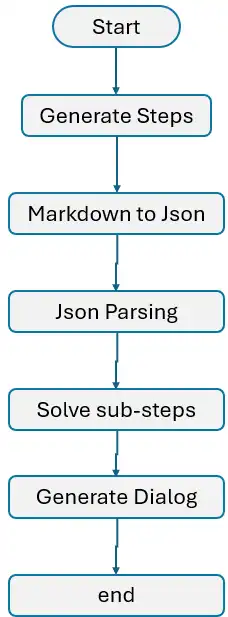
Let’s begin the process and evaluate how the current framework operates. For now, I am testing with only three images, though this can be extended to multiple images. The code will take images as input and pass this data to the graph’s entry point. Subsequently, each step will take the input from the previous step and pass the output to the next step until the process is completed.
output = []
for s in app.stream({"image_path": [f"./pdf_image/vision_P{i:03d}.jpg" for i in range(6)]}):
output.append(s)
with open('./data/output.json','w') as f:
json.dump(output,f)Output:

with open('./data/output.json','r') as f:
output1 = json.load(f)print(output1[10]['generate_dialog']['Dialog'][0])Output:
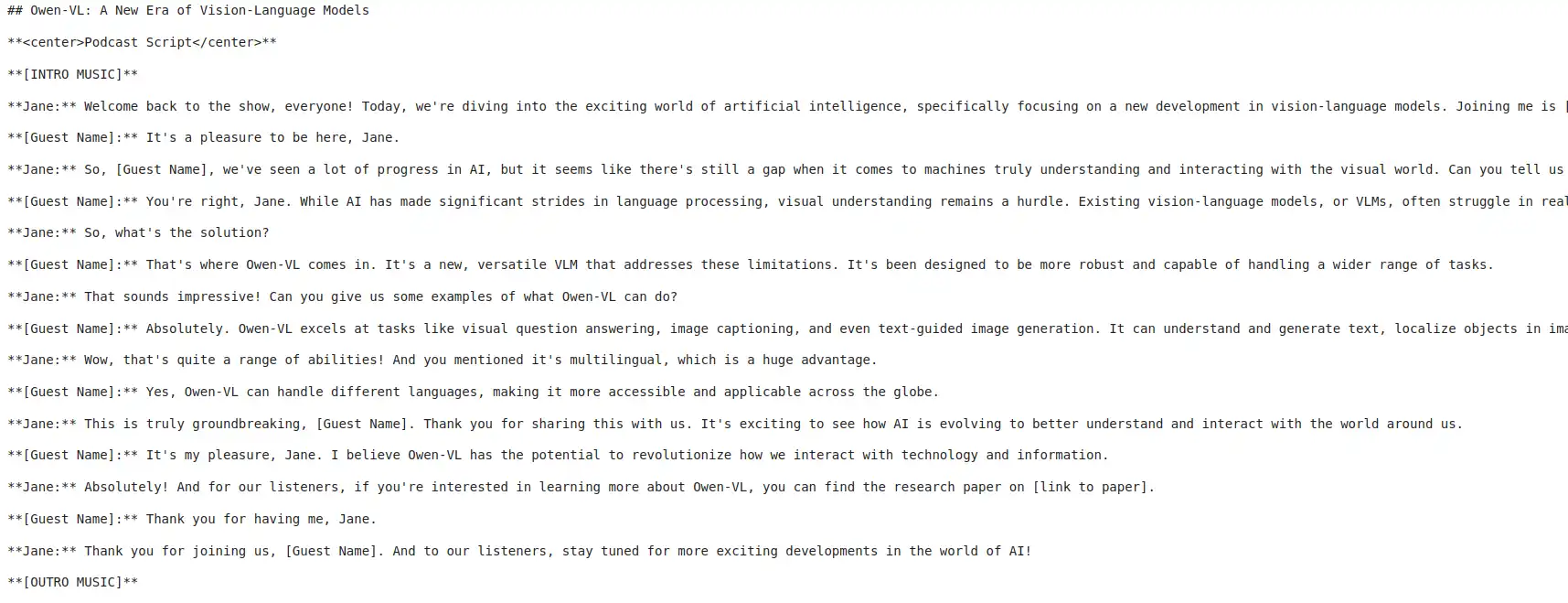
I’m using the following code to stream the results sequentially, where each plan and sub-plan will be mapped to a corresponding response.
import sys
import time
def printify(tx,stream=False):
if stream:
for char in tx:
sys.stdout.write(char)
sys.stdout.flush()
time.sleep(0.05)
else:
print(tx)topics =[]
substeps=[]
for idx, plan in enumerate(output1[2]['parse_json']['plan']):
topics.append(plan['step'])
substeps.append(plan['substeps'])Let’s separate the answers of every sub-step
text_planner = {}
stream = False
for topic,substep,responses in zip(topics,substeps,output1[3:10]):
response = responses['sovle_substeps']
response_topic = response['steps']
if topic in response_topic:
answer = response['solutions'][0].strip().split('Answer:')
answer =[ans.strip() for ans in answer if len(ans.strip())>0]
for q,a in zip(substep,answer):
printify(f'Sub-Step : {q}\n',stream=stream)
printify(f'Action : {a}\n',stream=stream)
text_planner[topic]={'answer':list(zip(substep,answer))}The output of Sub-steps and their Action

The last node in the graph converts all the answers into dialog. Let’s store them in separate variables so that we can convert them into voice.
stream = False
dialog_planner ={}
for topic,responses in zip(topics,output1[10:17]):
dialog = responses['generate_dialog']['Dialog'][0]
dialog = dialog.strip().split('## Podcast Script')[-1].strip()
dialog = dialog.replace('[Guest Name]','Robin').replace('**Guest:**','**Robin:**')
printify(f'Dialog: : {dialog}\n',stream=stream)
dialog_planner[topic]=dialogDialog Output

Dialog to Voice
from pydantic import BaseModel, Field
from typing import List, Literal, Tuple, Optional
import glob
import os
import time
from pathlib import Path
from tempfile import NamedTemporaryFile
from scipy.io.wavfile import write as write_wav
import requests
from pydub import AudioSegment
from gradio_client import Client
import json
from tqdm.notebook import tqdm
import sys
from time import sleepwith open('./data/dialog_planner.json','r') as f:
dialog_planner1 = json.load(f)Now, let’s convert these text dialogs into voice
1. Text To Speech
For now, I am accessing the tts model from the HF endpoint, and for that, I need to set the URL and API key.
HF_API_URL = config['HF_API_URL']
HF_API_KEY = config['HF_API_KEY']
headers = {"Authorization": HF_API_KEY}2. Gradio Client
I am using the Gradio client to call the model and set the following path so the Gradio client can save the audio data in the specified directory. If no path is defined, the client will store the audio in a temporary directory.
os.environ['GRADIO_TEMP_DIR'] = "path_to_data_dir"
hf_client = Client("mrfakename/MeloTTS")
hf_client.output_dir= "path_to_data_dir"
def get_text_to_voice(text,speed,accent,language):
file_path = hf_client.predict(
text=text,
language=language,
speaker=accent,
speed=speed,
api_name="/synthesize",
)
return(file_path)3. Voice Accent
To generate the conversation for the podcast, I am assigning two different accents: one for the host and another for the guest.
def generate_podcast_audio(text: str, language: str) -> str:
if "**Jane:**" in text:
text = text.replace("**Jane:**",'').strip()
accent = "EN-US"
speed = 0.9
elif "**Robin:**" in text: # host
text = text.replace("**Robin:**",'').strip()
accent = "EN_INDIA"
speed = 1
else:
return 'Empty Text'
for attempt in range(3):
try:
file_path = get_text_to_voice(text,speed,accent,language)
return file_path
except Exception as e:
if attempt == 2: # Last attempt
raise # Re-raise the last exception if all attempts fail
time.sleep(1) # Wait for 1 second before retrying4. Store voice in mp3 file
Each audio clip will be under 2 minutes in length. This section will generate audio for each short conversation, and the files will be saved in the specified directory.
def store_voice(topic_dialog):
audio_path = []
item =0
for topic,dialog in tqdm(topic_dialog.items()):
dialog_speaker = dialog.split("\n")
for speaker in tqdm(dialog_speaker):
one_dialog = speaker.strip()
language_for_tts = "EN"
if len(one_dialog)>0:
audio_file_path = generate_podcast_audio(
one_dialog, language_for_tts
)
audio_path.append(audio_file_path)
# continue
sleep(5)
break
return(audio_path)audio_paths = store_voice(topic_dialog=dialog_planner1)5. Combined Audio
Finally, let’s combine all the short audio clips to create a longer conversation.
def consolidate_voice(audio_paths,voice_dir):
audio_segments =[]
voice_path = [paths for paths in audio_paths if paths!='Empty Text']
audio_segment = AudioSegment.from_file(voice_dir+"/light-guitar.wav")
audio_segments.append(audio_segment)
for audio_file_path in tqdm(voice_path):
audio_segment = AudioSegment.from_file(audio_file_path)
audio_segments.append(audio_segment)
audio_segment = AudioSegment.from_file(voice_dir+"/ambient-guitar.wav")
audio_segments.append(audio_segment)
combined_audio = sum(audio_segments)
temporary_directory = voice_dir+"/tmp/"
os.makedirs(temporary_directory, exist_ok=True)
temporary_file = NamedTemporaryFile(
dir=temporary_directory,
delete=False,
suffix=".mp3",
)
combined_audio.export(temporary_file.name, format="mp3")consolidate_voice(audio_paths=audio_paths,voice_dir='./data')Also, to understand the Agent AI better, explore: The Agentic AI Pioneer Program.
Conclusion
Overall, this project is intended purely for demonstration purposes and will require significant effort and process changes to create a production-ready agent. It can serve as a proof of concept (POC) with minimal effort. In this demonstration, I have not accounted for factors like time complexity, cost, and accuracy, which are critical considerations in a production environment. With that said, I will conclude here. Thank you for reading. For more technical details, please refer GitHub.
Frequently Asked Questions
Ans. The Paper-to-Voice Assistant is designed to simplify the process of summarizing research papers by converting the extracted information into a conversational format, enabling easy understanding and accessibility.
Ans. The assistant uses a map-reduce approach, where it breaks down the research paper into steps and sub-steps, processes the information using LangGraph and Google Gemini LLMs, and then combines the results into a coherent dialogue.
Ans. The project utilizes LangGraph, Google Gemini generative AI models, multimodal processing (vision and text), and text-to-speech conversion with the help of Python libraries like pypdfium2, pillow, pydub, and gradio_client.
Ans. Yes, the agent can analyze PDFs containing images by converting each page into images and feeding them into the vision model, allowing it to extract visual and textual information.
Ans. No, this project is a proof of concept (POC) that demonstrates the workflow. Further optimization, handling of time complexity, cost, and accuracy adjustments are needed to make it production-ready.






